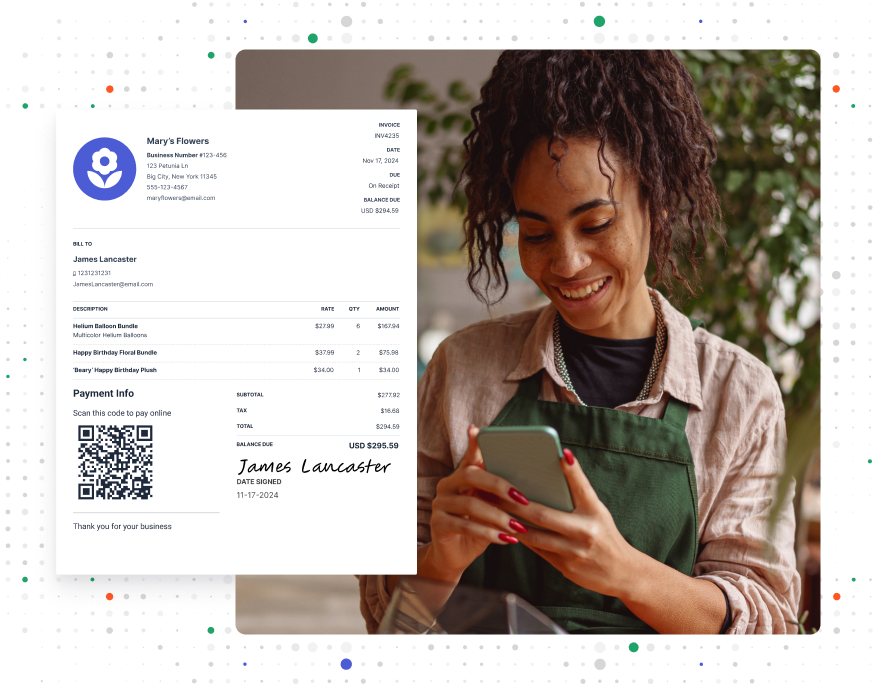Small Business Tax Returns: Everything Business Owners Need To Know

For many entrepreneurs, the words “tax return” cause anxiety. But a solid grasp of the regulations takes the stress out of tax season so you can focus on growing your company.
Here’s everything you need to know to master your small business tax return. We’ll explore the types of business taxes, how to file your federal tax return, and some expert tips to help you stay organized. Get ready to tackle tax season with confidence.
5 Types of Small Business Taxes
Let’s review the main types of taxes that apply to small businesses. Depending on your business structure, you may need to pay some or all of the following:
1. Income Tax
As the name suggests, income tax applies to the taxable income from your business. How you pay income tax depends on your business entity type.
If your business is a sole proprietorship or partnership, you report business income on your personal tax return. Sole proprietors use Schedule C to report profit or loss. Partners use Schedule K-1. In both cases, your share of the business income “passes through” to your individual return.
If your business is a C corporation, it files its own corporate return and pays taxes at the corporate income tax rate. If it’s an S corporation, the income passes through to the shareholders’ individual returns, similar to a partnership.
RELATED ARTICLE — Filing Business Taxes for LLC for the First Time: Everything You Need To Know
2. Estimated Tax
Estimated taxes aren’t a separate tax. They’re a way to pay your income and self-employment taxes throughout the year.
When you’re an employee, your employer withholds taxes from your paycheck. But as a business owner, you have to pay tax yourself. Business owners typically need to make quarterly estimated tax payments to the IRS.
If you expect to owe $1,000 or more in taxes for the year after subtracting withholding and refundable credits, make estimated payments each quarter. You can use Form 1040-ES to calculate your estimated taxes. Corporations use Form 1120-W.
When you pay enough in estimated taxes, you avoid penalties. As a general rule, you should aim to pay at least 90% of your current year’s tax liability or 100% of the prior year’s liability.
3. Self-Employment Tax
If you’re self-employed, you have to pay Social Security and Medicare taxes yourself. This is called the self-employment tax.
The 2024 self-employment tax rate was 15.3%—12.4% for Social Security and 2.9% for Medicare. Pay this tax if your net earnings from self-employment are $400 or more for the year. You can calculate your self-employment tax using Schedule SE.
The silver lining is that you can deduct half of your self-employment tax on your income tax return to reduce your taxable income. So while self-employment tax is an extra cost, the deduction helps cushion the impact on your bottom line.
4. Employment Taxes
If you have employees, your business has to pay certain federal employment taxes.
As an employer, you withhold Social Security and Medicare taxes along with federal income tax from your employees’ wages. You also have to pay the employer portion of the Federal Unemployment Tax Act (FUTA).
Report employment taxes on Form 941 each quarter. FUTA tax is reported annually on Form 940. And at the end of the year, you need to prepare W-2 forms for employees and 1099 forms for independent contractors.
5. Excise Tax
Some businesses need to pay excise taxes. Usually, these taxes apply if you operate in a field that could harm consumers or the environment. This includes gasoline and alcohol.
The IRS has a list of goods and services subject to federal excise tax in Publication 510. These taxes can be charged at the federal, state, and local levels. If any excise taxes apply to your business, you need to file Form 720 quarterly to report and pay the tax. Some situations have different filing requirements, so review the instructions thoroughly.
RELATED ARTICLE — What Is a Tax Invoice?
How To File Federal Income Taxes for Small Businesses

Here’s how to file your federal tax return for a small business:
1. Gather Your Records
First, get all your financial records together. This includes things like:
- Income and expense reports
- Bank and credit card statements
- Receipts for business purchases and expenses
- Payroll records (if you have employees)
- 1099 forms for any contractors you’ve paid
- Last year’s business tax return
Having everything organized and in one place makes it easier to fill out your return. If you use accounting software, you can generate many of these reports automatically. If not, set aside some time to sort through your records and get everything in order.
2. Choose the Right Form
The tax form you use depends on your business structure:
- Sole proprietorships and single-member LLCs use Schedule C (Form 1040)
- Partnerships and multi-member LLCs use Form 1065
- C corporations use Form 1120
- S corporations use Form 1120-S
Make sure you’re using the right form for your business structure. Using the wrong form could lead to processing delays.
3. Fill Out the Form
Once you have your records and the correct form, it’s time to fill it out.
For sole proprietors, report your business income and expenses on Schedule C to find your net profit or loss. Transfer this to your personal 1040. Be sure to take all relevant deductions. This can lower your taxable income.
For corporations, report your business financials and calculate your tax bill on Form 1120. Provide your income statement and balance sheet. You also have to report your income, gains, losses, deductions, and credits.
For partnerships and S corps, report your business financials on your 1065 or 1120-S. Then, give each partner or shareholder a Schedule K-1. This shows their portion of the profits or losses to report on their personal return. While the partnership or S corp itself doesn’t pay income taxes, you still have to file an informational return.
RELATED ARTICLE — What Is Invoice Reconciliation?
5 Small Business Tax Planning Tips

Tax planning is a year-round process, not just something you take care of in April. Preparing throughout the year can ease the burden of filing your return. Here are some tips:
1. Know What You Can Deduct
Many business expenses are tax-deductible. Common write-offs include business travel, office supplies, and salaries and benefits. Keep detailed records of these expenses, including the date, amount, and business purpose. Consult the IRS for a full list of deductible business expenses.
2. Consider Hiring a Pro.
Tax laws are complex. Consider hiring a CPA or enrolled agent to help you comply and plan for tax season. While it’s an extra cost, their expertise often leads to huge tax savings.
3. Set Aside Money for Estimated Taxes
If your business has to pay estimated taxes quarterly, disciplined saving is a must. Set aside around 30% of your business income in a separate account for taxes. This helps avoid a big tax bill at year-end and potential underpayment penalties.
4. Look at Tax Law Changes
Tax regulations change often. And these changes can have a big impact on your business. Stay informed by following IRS alerts, reading industry blogs, and having regular check-ins with your tax advisor. Being proactive helps you plan ahead and take advantage of any beneficial changes.
5. Keep Good Records
Having everything in one place saves time and headaches when tax season comes. Use software like Invoice Simple to track income and expenses and digitize receipts from your phone. Make it a habit to update your records often instead of letting them pile up for smooth tax preparation.
RELATED ARTICLE — What Is a Sales Invoice & How to Create One
Keep Your Finances Organized
Organizing your business finances year-round is the secret to stress-free tax management. And Invoice Simple’s user-friendly platform makes that easier than ever.
With Invoice Simple, you can create and send professional invoices in minutes, track income and expenses effortlessly, and generate insightful financial reports with a single click. No more sifting through shoe boxes of receipts or trying to reconcile accounts at the last minute.
Start Your First
Invoice Today
Create customized and professional
invoices and connect with clients
